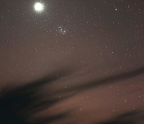
Rainbow Astro RST-135
US price: $3,895 (head only) rainbowastro.com
What we like
Small and portable Accurate Go To Works in equatorial or alt-az mode
What we don't like
Large periodic error Lacks periodic-error correction Hand controller steep learning curve
THE ADAGE THAT ‘bigger is better’ is not aging well, at least not when it comes to astrophotography. The current trend is toward portable imaging with smaller telescopes, which means smaller mounts are needed to put them on. And along with this new emphasis on portability, a new technology has arrived — the ‘harmonic’ mount. Such units use ‘strain-wave’ gearing technology, originally developed for industrial robotics, to create compact but very strong mounts capable of handling a hefty telescope without the need for heavy counterweights to balance the load.
My first encounter with strainwave gearing was at an event in 2018, where Korean manufacturer Rainbow Astro exhibited some of the earliest mounts featuring this technology. My first impression of this tiny beast was “that’s inconceivable”. I had a hard time believing such a tiny mount could produce good results with much more than telephoto lenses.
Skipping forward a few) to see how well it performs.


